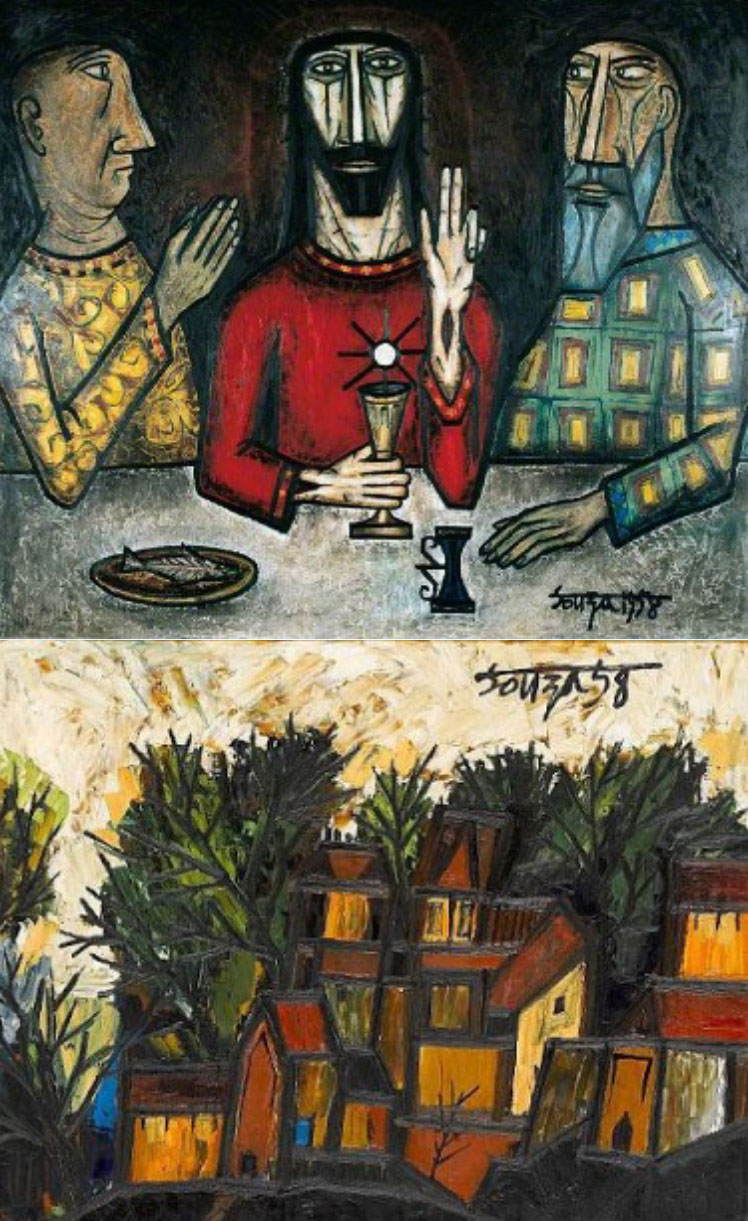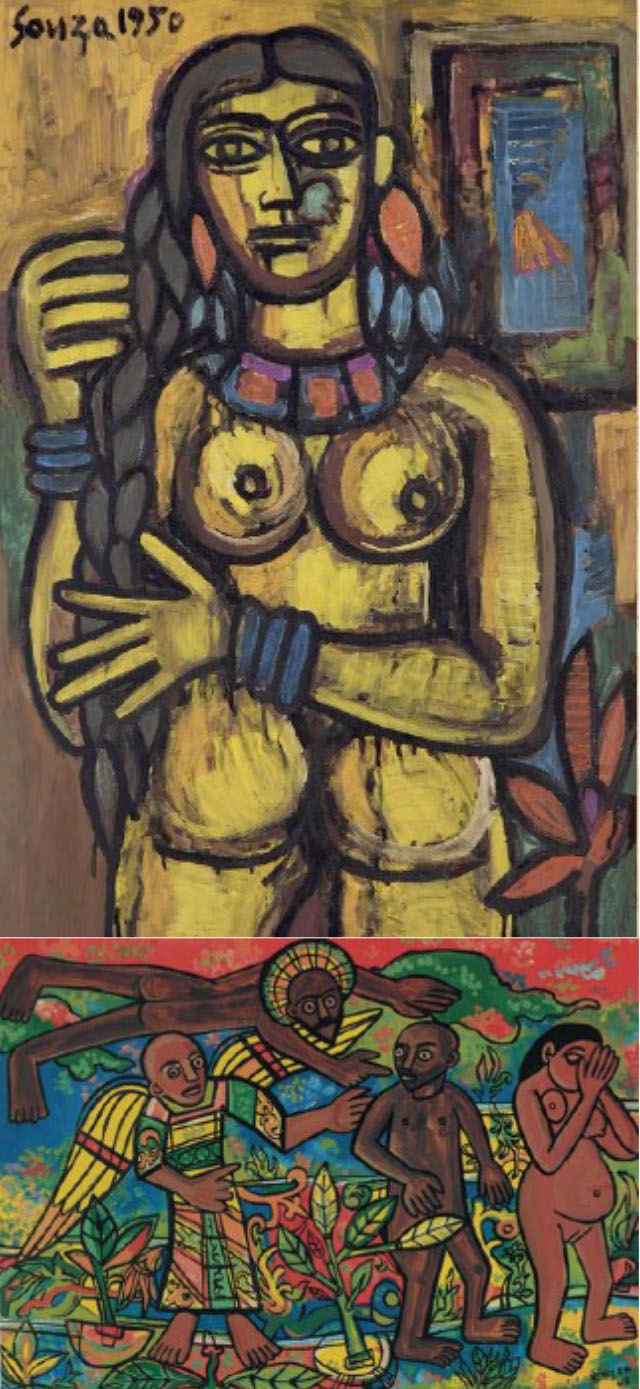Biography
Francis Newton Souza, born on the 12th of April 1924 in Saligao, Goa, was the founder member of the
Progressive Artists Group who is largely responsible for shaping the Modern Art movement in India. He
was brought up a strict Roman Catholic under Portuguese Colonial rule and later a member of the
Communist Party. Inspite of the confusion of names, Souza was entirely Indian by blood. The name Newton
came into the family because his father - also Newton - had an English godfather. The name Francis was
added a little later by Souza’s mother, in thanksgiving to Goa’s patron saint, St. Francis Xavier, for having
rescued her son from an attack of smallpox. She vowed not only that she would rename her son after the
saint, but that she would do everything in her power to encourage him to become a Jesuit priest. He has
written a lot about these early years in Words and Lines:
“I was born in Goa in 1924. My grandfather and grandmother were both chronic drunkards.
Grandfather was a principal of a village school on Assolna, Salsette - a school his forefather
had founded. My father, as a reaction to their bibulousness, never touched other liquid than
water. He became a chronic teetotaler. On his wedding day the toast wine was poured over
his head, since he would not drink it. But it is said that the progeny of bibulous progenitors
are highly imaginative people. By atavism, it seems, the visions of a tipsy grandfather, pink
elephants and the rest of the menagerie are transferred to the grandchildren, who see similar
visions without being tipsy. You’ve only to see my paintings to know whether this is right or
wrong."
Brought up a strict Catholic, Souza admits that it was the Roman Catholic Church in Goa which gave him
the first ideas of images and image-making. In 1937, he was sent to a Jesuit school in Bombay as his mother
had promised. It was scarcely a success. Although he was thinking seriously of becoming a priest, and was
studying Latin to that end, the Jesuits who ran the school did not find anything godly in his indifference to
school discipline, nor in his aptitude for drawing. He was often suspected as having done the drawings in the
school lavatory which after examining, Souza would find badly drawn and even correct it. After two years, he
was expelled as undesirable, and that was the end of his brief career as a budding priest.

Souza promptly joined the Sir J.J. School of Art in Bombay when he was 16.
Since it was in a British Colony, and had an Associate Royal Academician as
its principal, it is easy to imagine what would the would-be artists of Bombay
were encouraged to admire and emulate. At the time, Souza seems to have
accepted its values, at least to the point of being the prize pupil for four years
and to have been content to learn the dull disciplines of his profession, without
rebelling against the entrenched principles upon which those disciplines were
founded. In 1944 he began to take part in Left-Wing political activities aimed
at bringing the British colonial rule to an end. This made him increasingly the
suspect in the eyes of the British staff at the art school. He found himself
failing the end-of-the-year examination, joining in a school strike which
resulted to him getting expelled again. It was on this period, June 1945, he was
21 that he went home and painted a picture that was utterly different from
anything he had done before. Called “The Blue Lady", it was created with
paint squeezed straight out of the tube and spread with a palette knife. It was
an angry impulsive picture, and in painting it he discovered the way he wanted
to paint. Six months later, he held his first one-man show and sold a number
of pictures - including “The Blue Lady", bought by Dr. Herman Goetz for the
Baroda Museum, where it still hangs.
Having been expelled from school, Souza had the luxury of time which he took to
studying in libraries where he discovered for the first time illustrations of classical
Indian art and of modern European painting. This was for him a revelation for it
never had occurred to the teachers at the art school that their Indian pupils might
benefit from studying the art of their ancestors or of their European contemporaries.
Souza then made a passionate study of Indian art and was particularly moved by the
South Indian bronzes and the sublimely erotic carvings on the temples of
Khajuraho. Both made a lasting impression on him, and were largely responsible for
awakening the imagination of the young painter. One of the things which shocked
him at that time was the ignorance of this great traditions on the part of men who
called themselves painters. An ignorance which spread to every corner of the Indian
art world. Nowhere did Souza find any knowledge or appreciation of India's own
native heritage.
From 1945, he veered increasingly towards Communism and became a party
member in 1947, the year of India’s independence. For a time, Souza thought his art
could serve their ideals. The following year, Souza founded the Progressive Artists
Group. He also left the Communist Party.
He still believes that art is propaganda, but he no longer believes it possible to make
men more conscious of their suffering by showing people suffering.

“They told me to paint in this way and that, I was estranged from many cliques who wanted me to
paint what would please them. I do not believe that a true artist paints for a coteries or for the
proletariat. I believe with all my soul that he paints solely for himself. I have made my art a
metabolism. I express myself freely in paint in order to exist. I paint what I want, what I like, what I
feel."
In 1949, he and his wife boarded a ship for London and in 1955, held a one-man show at Gallery One in
London and also had his autobiographical essay ‘Nirvana of a Maggot’ published. It was a hard-earned
success for Souza as he have been through a lot of rejections and struggles during his early years in London.
Yet it was in the Paris art gallery, the Iris Clert, that Souza found his first really big patron. In 1956, Harold
Kovner, a wealthy American had been shown
Souza’s works where he jumped upon seeing
them. Within 24 hours he met with Souza,
given him money, taken away some pictures,
and made arrangements for the future. Souza
had to keep him supplied with pictures of his
own choosing and in return, Kovner would
give him money. This went on for four years
and Souza, for the first time in his life, did
not have to worry about his finances. Mr.
Kovner owns 200 paintings of Souza now.
In 1959 a collection of his autobiographical essays, ‘Words and Lines’, was published, and in 1962 a
monograph on his work by Edwin Mullins was published as well. Two retrospectives of his work were
organized by Art Heritage, New Delhi, in 1986 and 1996. Souza also participated in a work-live programme
in Los Angeles, hosted by Saffronart in 2001. Souza passed away in Mumbai 2002. Some important
posthumous exhibition of his work include, ‘F.N. Souza’ in New York, in 2008; ‘F.N. Souza: Religion &
Erotica’ at Tate Britain, London, in 2005-06; ‘Self-Portrait: Renaissance to Contemporary’ at a gallery, in
London, in 2005; and ‘Francis Newton Souza’ in galleries in New York and London, in 2005.
Text Reference:
Excerpt from the book, Souza by Edwin Mullins published in 1962